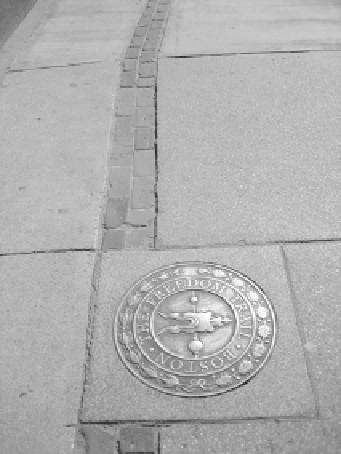Travel Reference
In-Depth Information
Figure 6.8
Boston's Freedom Trail embedded in the sidewalks to guide tourists along
the path
accidents, reduce injuries and lessen the liability of the trail owners (Figure
6.9). Trailhead signs that show gradients, paving material and levels of dif-
ficulty of various parts of the trail help users determine for themselves
whether or not they will be able to utilize the trail or which portions they
can visit (Cook, 1988). This is critical in helping to alleviate frustrations or
potentially risky situations (Kirschbaum
et al.
, 1999).
Interpretation is the third goal of signage. Interpretive signage (discussed
later) is important for providing information and education about the route
being visited and the salience of specific sites along the way.
Fourth, good signs can help steer people away from sensitive spots (e.g.
bird colonies) or crowded areas into more resilient locations and less-crowded
zones. Logos and signs may also be used to disperse heavy traffic on scenic
or access routes during high season. Less obvious ways to important destina-
tions can be signposted to alleviate traffic, provide a wider variety of land-
scapes and to spread the benefits of tourists' expenditures to other
communities off the normal route (Scottish Tourist Board, 1986).
Finally, a unique sort of sign is public message boards. These are valuable
information sources when those who passed before are able to leave messages
for people they know or for lagging hikers about conditions ahead. They are
also useful for park and path managers to post daily conditions or announce-
ments for trail users - information that may change on a daily basis (e.g. fire
danger, aggressive animal sightings or severe weather warnings). Despite the

Search WWH ::

Custom Search